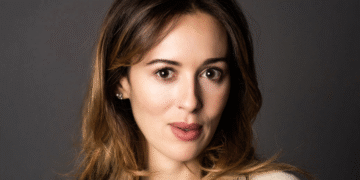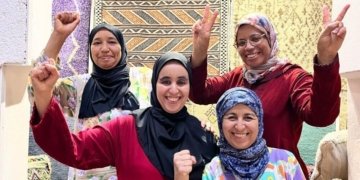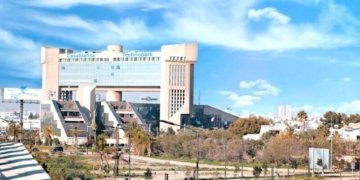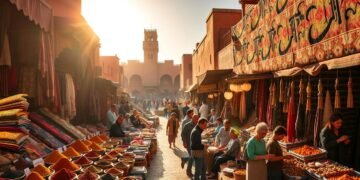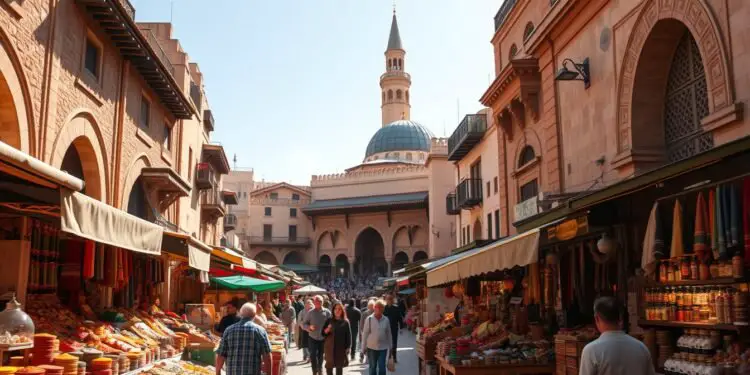Ever wandered through a city where time stands still? Fes, Morocco’s cultural heart, offers just that. With over 1,200 years of history, this UNESCO-listed gem invites travelers into its car-free medina, a maze of vibrant souks and ancient architecture.
Unlike other Moroccan cities, Fes blends medieval charm with living traditions. Its walkable alleys lead to hidden madrasas, bustling tanneries, and aromatic spice stalls. Perfectly positioned between Marrakech and Chefchaouen, it’s a must-visit for any Morocco trip.
Ready to explore? This guide covers top attractions, local cuisine, and practical tips for navigating Fes like a pro.
Key Takeaways
- Fes is Morocco’s cultural capital with a UNESCO-listed medina.
- The car-free old town features 9,000+ narrow, walkable streets.
- Ideal for a 2-day visit, packed with historic sites and local flavors.
- Located between Marrakech and Chefchaouen for easy itinerary planning.
- Authentic experiences include tanneries, madrasas, and traditional souks.
Welcome to Fes: Morocco’s Cultural Heart
Few places capture Morocco’s soul like Fes, where history breathes through every alley. Founded in the 9th century by Idris I, this car-free city became a beacon of Islamic learning and trade. Today, its medina—a maze of 9,400+ historic buildings—remains frozen in time.
A Glimpse into Fes’ Rich History
Fes flourished between the 12th and 14th centuries under the Marinid dynasty. Its fame grew with Al Quaraouiyine, the world’s oldest university, established in 859 AD. Scholars and artisans flocked here, shaping its legacy as a hub for theology, science, and craftsmanship.
Medieval trade routes brought wealth, visible in the intricate zellige tiles and carved cedar doors. The city’s 156,000 residents still practice centuries-old trades, from leather tanning to metalwork.
Why Fes is a UNESCO World Heritage Site
UNESCO honored Fes for preserving its urban fabric and traditional industries. The medina’s layout—a labyrinth of alleys and courtyards—reflects 1,200 years of Islamic urban design. Challenges like erosion and overcrowding test conservation efforts, but restoration projects keep its magic alive.
From the iconic Chouara Tannery to the geometric patterns of Bou Inania Madrasa, Fes offers a masterclass in Moroccan artistry. It’s not just a relic; it’s a living testament to human ingenuity.
What to Do in Fes: Must-See Attractions
Step into a world where medieval craftsmanship still thrives. Fes’ top landmarks blend history with artistry, offering glimpses into Morocco’s golden age.
Explore the Chouara Tannery
The Chouara Tannery, operational for over 1,000 years, is a sensory marvel. Watch artisans dye leather in natural pits using techniques unchanged since the 9th century.
Visit early morning for vibrant dye views. Bring mint leaves to counter strong odors. A 50 MAD fee grants rooftop access with panoramic medina vistas.
Step Inside the Bou Inania Madrasa
This 14th-century theological school dazzles with carved cedar and geometric zellige tiles. Its green minaret stands tall above Fes El Bali.
Admire the courtyard’s stucco carvings and Quranic inscriptions. Arrive at opening (9 AM) to avoid crowds. Entry costs 20 MAD.
Admire the Royal Palace Doors
The royal palace’s 80kg bronze doors, adorned with arabesques, symbolize Morocco’s regal heritage. Though interiors are closed, the facade is a photographer’s dream.
Golden hour lights up the mosaic patterns. Nearby lemon groves offer shaded rest spots.
Wander the Labyrinth of Fes Medina
Lose yourself in a living museum where every turn reveals centuries-old secrets. The 540-acre medina, with its 9,500 alleys, is the world’s largest car-free urban zone. From cobalt-blue doorways to the hum of copper workshops, it’s easy to get lost—and that’s half the fun.
Highlights of Fes El Bali
Start at Bab Boujloud, the medina’s iconic blue gate. Follow Talaa Kebira, the main artery, past stalls selling saffron and handmade ceramics. Don’t miss Nejjarine Fountain, a mosaic masterpiece hidden near woodcraft souks.
For quiet reflection, visit Funduq al-Najjarin. This restored 18th-century caravanserai now houses a museum of wooden arts. Its rooftop offers rare medina panoramas.
Navigating the Souks Like a Local
The souks thrive on rhythm. Seffarine echoes with hammered metal, while Attarine overflows with cumin and cinnamon stacks. Bargain politely—start at 40% of the asking price for leather goods.
Use bakeries as landmarks; their ovens stay lit all day. Step aside for donkeys carrying goods—they own these streets. Fridays bring prayer-time lulls; plan visits around midday closures.
Unmissable Tours in Fes
Discover Fes beyond its ancient walls with immersive tours that bring history to life. Whether navigating the medina’s labyrinth or venturing to nearby Roman ruins, expert-led excursions deepen your understanding of Morocco’s cultural heartbeat.
Guided Walking Tours of the Medina
Morning guided tours reveal the medina’s vibrant energy as souks open. Desert Day Tours’ 3-hour “Funky Fes” route includes artisan workshops and hidden madrasas. Evening walks, like Fez Guided Tours’ lantern-lit strolls, showcase quieter alleys and sunset panoramas.
Compare operators by their focus—some prioritize history, while others highlight local crafts. Always confirm if fees include rooftop access or tannery visits.
Day Trips to Meknes and Volubilis
Volubilis, 40km from Fes, dazzles with Roman mosaics under morning light. Rent a guidebook onsite for context. Combine it with Moulay Idriss, a whitewashed pilgrimage town, for a full-day excursion.
Grand taxis offer flexibility, but organized day trips include Heri es-Souani’s monumental granaries in Meknes. Check if photography permits are needed for archaeological sites.
Experience Fes from Above: Best Rooftops
Fes reveals its true beauty when seen from above—discover its hidden heights. These elevated spots offer respite from the medina’s bustle while framing the city’s skyline. Whether sipping mint tea or capturing golden hour, each rooftop tells a unique story.
Riad Fes’ Panoramic Terrace
The glass-enclosed terrace at Riad Fes unveils Atlas Mountain vistas. Arrive before sunset for soft lighting on the medina’s terracotta domes. Staff serve orange blossom cocktails—perfect with the 360-degree view.
Dress modestly; shoulders covered after dusk. Private bookings suit groups, enhancing intimacy. Summer visits? Mornings avoid heat glare on camera lenses.
Sunset Views at Dar Seffarine
This 14th-century gem overlooks copper workshops, where artisans hammer rhythms into evening. The rooftop’s west-facing angle ignites the sky with tangerine hues. Try their signature mint tea paired with almond pastries.
Winter brings crisp air ideal for photography. Minimum orders apply post-6 PM. For unobstructed shots, secure corner seats early.
Pro tips: Café Clock’s camel burger pairs well with twilight panoramas. Borj Nord’s historic tower offers alternate angles. Always ask permission before photographing locals from above.
Where to Stay in Fes
From opulent riads to cozy hostels, Fes offers lodging options for every traveler’s style and budget. Staying inside the medina plunges you into historic charm, while modern hotels near Ville Nouvelle provide contemporary comforts.
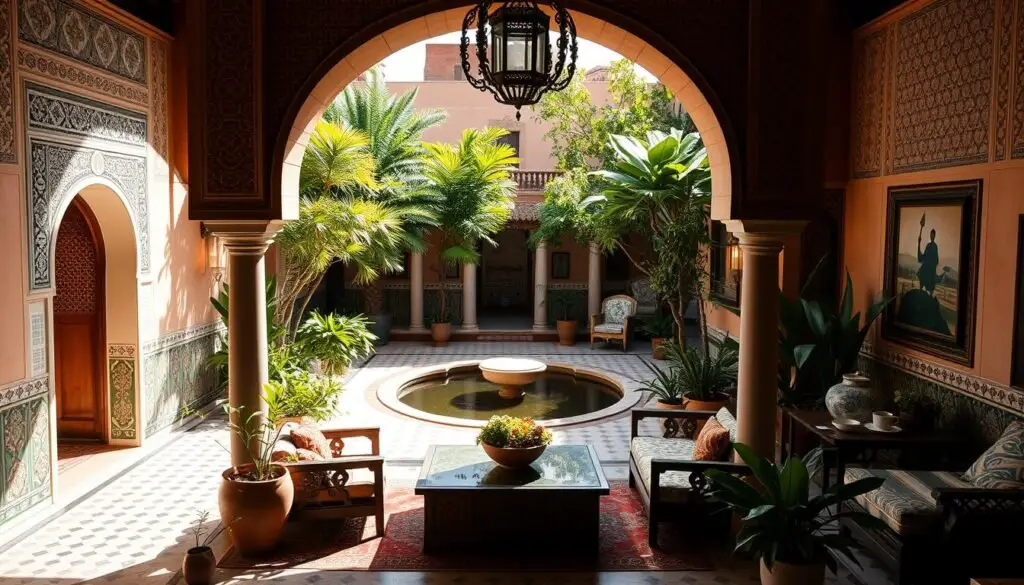
Luxury Riads in the Medina
Riad Fes dazzles with a palm-shaded pool and rooftop views of the Atlas Mountains. Its 33 rooms feature hand-carved cedar ceilings, while the restaurant serves refined Moroccan cuisine.
For intimate luxury, Palais Amani‘s 19 rooms surround a citrus garden. Join their cooking classes to master tagine recipes. Both riads offer hammam access—perfect after exploring the medina.
Budget-Friendly Hostels
Medina Social Club keeps costs low at $14 per night for dorms, including breakfast. Their rooftop terrace hosts live Gnawa music evenings.
Riad Verus provides private rooms from $35 per night with traditional zellige tiles. Its Batha location offers easy medina access without the maze-like alleys.
Book directly with riads for better prices and room choices. Third-party sites work for last-minute deals. Prioritize air conditioning in summer—some historic properties lack modern cooling.
Traditional Moroccan Food to Try in Fes
Moroccan cuisine tells stories through spices—nowhere more vividly than in Fes. The city’s food blends Berber, Arab, and Andalusian influences, served in bustling souks or serene riads. Whether savoring street snacks or multi-course feasts, every dish reflects traditional Moroccan craftsmanship.
Street Food Gems
Dive into Fes’ alleys for bessara soup, a creamy fava bean dip topped with olive oil. Crispy maakouda (potato fritters) pair perfectly with harissa. Morning vendors near Bab Boujloud serve these staples fresh.
Spot reheated dishes by checking steam—fresh food sizzles. For unique bites, try pastilla: flaky pastry stuffed with pigeon, almonds, and cinnamon. Locals swear by Bakchich Café’s version.
Must-Visit Restaurants
Ruined Garden charms with chicken daghmira (slow-cooked with olives) in a leafy courtyard. Their couscous, hand-rolled daily, melts in your mouth. Vegetarians relish zaalouk (smoky eggplant dip) and saffron-infused veggie tagines.
For upscale dining, Nur’s seven-course menu reimagines traditional Moroccan flavors. Book ahead—their 12-seat space fills fast.
Master the Art of Moroccan Cooking
Cooking classes at Riad Dar Anika focus on family recipes, while Palais Amani’s workshop includes a souk tour. Both teach tagine techniques, but Palais Amani’s hammam access adds luxury.
Tea culture shines here. Compare mint tea’s sweetness to saffron-infused versions at Café Clock. Bakeries hide gems like msemen—flaky pancakes best enjoyed warm with honey.
How to Get Around Fes
Navigating Fes feels like stepping into a medieval puzzle—here’s how to master it. The medina’s car-free streets demand patience, but rewards with hidden gems at every turn.
The best way to explore the medina? On foot. Its 9,500 alleys wind past souks and mosques, though steep inclines challenge some travelers. Download Maps.me for offline navigation—GPS works even without signal.
For longer distances, petit taxis (blue for city, red for intercity) zip through Fes. Standard daytime fares start at 20 MAD. Agree on prices upfront to avoid surprises. After 8 PM, rates jump to 230 MAD.
Donkeys rule the medina’s narrow streets, hauling goods through tight corners. Step aside—they have right-of-way. Night transport? Book hotel pickups; taxis vanish after dark.
From the train station, CTM buses or taxi queues offer the easiest way to get around. Bus #16 links the airport for just 5 MAD. Note: Medina’s uneven terrain may limit accessibility.
Safety Tips for Travelers in Fes
Smart travelers know safety starts with awareness—here’s how to navigate Fes confidently. While most people welcome visitors warmly, a bit of caution enhances your experience.

Beware of “closed road” guides claiming detours. Licensed guides wear official badges—verify before hiring. For souk purchases, start haggling at 50% of the initial price.
Secure valuables in crossbody bags or hidden money belts. Pickpockets target crowded alleys near Bab Boujloud. Women should pack scarves for shoulder coverage in conservative areas.
Always ask permission before photographing locals or religious sites. Police (dial 190) patrol the medina but avoid dark alleys after sunset. Stick to well-lit main streets at night.
Taxi drivers may inflate prices—agree on fares upfront. If lost, seek help from shopkeepers rather than street people. A bit of common sense keeps your Fes adventure smooth.
Best Time to Visit Fes
Timing your visit right unlocks Fes’ true magic—cool breezes, fewer crowds, and vibrant festivals. Spring (March-May) and fall (September-November) offer ideal weather, with temperatures hovering around 75°F (24°C). These seasons balance comfort with manageable tourist numbers.
Summer turns the medina into an oven, with July highs hitting 104°F (40°C). If visiting this time, plan activities for early morning or late afternoon. Many riads have pools for midday cooling off.
Ramadan shifts the city’s rhythm—restaurants close until sunset, but evenings buzz with energy. Visiting during this holy month requires a day-time snack stash and respectful behavior. Hotel prices often dip slightly.
Cultural events elevate certain periods:
- Fes Festival of Sacred Music (late May-early June): Book 6+ months ahead
- Sufi Culture Nights (April): Intimate evening performances
- Cherry Festival (June): Day trips to nearby Sefrou
Winter demands a bit more planning—pack layers for chilly evenings. February offers the lowest hotel rates, while December sees European holiday crowds. The medina stays 5-10°F warmer than Ville Nouvelle due to its enclosed design.
For photography, golden hour shines year-round. November brings crisp air perfect for rooftop shots. Whenever you come, Fes rewards those who match their itinerary to the season.
Conclusion: Your Unforgettable Fes Adventure
Your trip to Morocco’s cultural capital promises memories that linger. From the vibrant Chouara Tannery to the medina’s maze-like alleys, each moment immerses you in history. Extend your stay with a 3-day itinerary—add Meknes or Volubilis for deeper exploration.
Pack light but smart: comfortable shoes for cobblestones and a scarf for modesty. Respect local customs by dressing modestly and asking before photographing people. Golden hour at Borj Sud offers perfect sunset shots.
Ready to craft your ideal experience? Start planning now to uncover Fes’ hidden gems. Whether two days or more, this city leaves no visitor unchanged.
FAQ
What are the must-see attractions in Fes?
Don’t miss the Chouara Tannery, Bou Inania Madrasa, and the grand doors of the Royal Palace. These landmarks showcase Fes’ rich history and craftsmanship.
Is a guided tour worth it in Fes?
Yes! A guided tour helps navigate the maze-like Medina while uncovering hidden gems like souks, historic madrasas, and rooftop views.
What’s unique about the Chouara Tannery?
This 14th-century tannery is one of the oldest in the world. Watch artisans dye leather using traditional methods—best viewed from a terrace.
How do I explore Fes Medina without getting lost?
Stick to main streets like Talaa Kebira, use landmarks for orientation, or hire a local guide. Getting lost is part of the adventure!
Are there good food experiences in Fes?
Absolutely! Try traditional Moroccan dishes like pastilla or join cooking classes. The Blue Gate area has top-rated restaurants.
What’s the best time to visit Fes?
Spring (March–May) and fall (September–November) offer mild weather. Summers can be hot, while winters are cooler but less crowded.
Where can I find the best rooftop views?
Head to Riad Fes or Dar Seffarine for stunning panoramas of the Medina and Atlas Mountains at sunset.
Is Fes safe for travelers?
Yes, but stay alert in crowded souks, avoid poorly lit alleys at night, and keep valuables secure. Petty theft is rare but possible.
Can I visit Meknes from Fes on a day trip?
Definitely! Meknes and Volubilis (Roman ruins) are just 1–2 hours away. Many tours combine both in a single day trip.
What’s special about Bou Inania Madrasa?
This 14th-century Islamic school features intricate zellij tiles and carved cedar wood. It’s one of the few madrasas open to non-Muslims.


